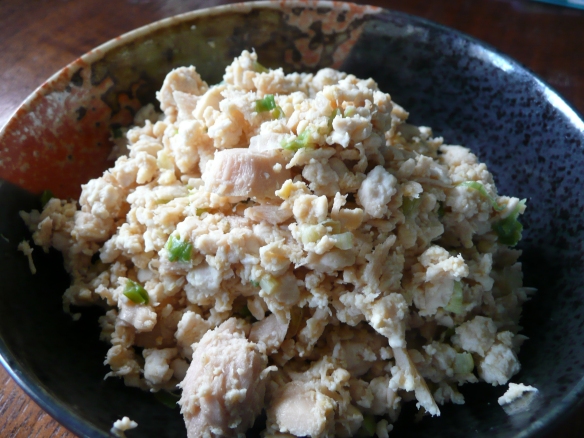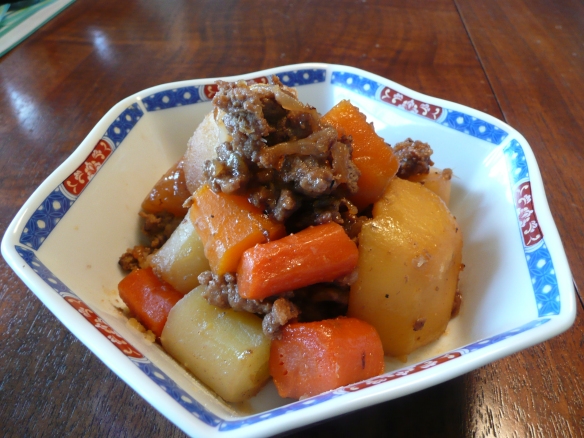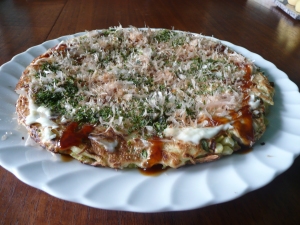
Iri-dofu, Japanese style tofu scramble
There are many different cultures assimilated into Japan from other countries. Since I live in the US, that is the most obvious connection. However, we recently rented a cottage on the Oregon Coast with our sister-in-law’s family for about 5 days and learned about some of the differences. We cooked many wonderful local seafood dishes in our rental cottage, and I found some very interesting differences between Japanese and American food cultures.
I offered to cook during the trip, and as all of us were sightseeing together, we also went shopping together on the way back home. Each time, I asked what everyone wanted to eat, etc, to be a nice sister-in-law. Very PC, right? For some reason, my sister-in-law Amy thought the amount of things I tried to get for dinner (especially meat and seafood) was very small. At our house, we normally buy 1/2 pound, which is 8 oz (225g) for two of us, unless we want to make extra for leftovers. My husband (her brother) eats what I cook everyday, and we often go grocery shopping together, so he’s ok with 4 oz per person thing. As a matter of fact, that’s what the FDA suggests as a “healthy” not “hefty” serving size. (Yes, that deck of a card portion thing, if you’ve seen it somewhere.) Given that they don’t live with us I decided 5-6 oz per person should be more than enough. So, for 4 of us, I though1 1/2 pound (6oz each) would be plenty. What I didn’t tell them was that I was planning to cook 2-3 more dishes, which was more than the side of “steamed green beans and corn.”
At dinner, they didn’t eat as much as they said they would eat. The total amount of food from all the dishes I cooked for dinner was actually a lot more than they are used to, so we ended up with quite a bit of leftovers. It was like 8+1+1=10 vs 4+3+2+2=11. I didn’t want to look like this evil person who’d be so stingy that I left everybody hungry for the night, so I decided on the 8 oz portion, and it ended up 8+3+2+2=15! This makes total sense. Americans are used to one big dish and maybe a tiny salad or side (unless it’s Thanksgiving or something), but Japanese eat one smaller main dish (with a lot less animal protein), and many side dishes which consists of many different ingredients, as you see in the mathematical formula. I read in Japan before that we should try to eat 30 different ingredients everyday (and ideally its different from day to day.) In the US…. hmm…… No wonder many Americans take multi-vitamins and Japanese don’t seem to be so into vitamins. Culturally, we feel like we should take them all from the food we eat!
Probably the best reflection of these differences is the quintessential American and Japanese dinner out. American version: Nice extra large steak, extra large potato, lots of sour cream, and maybe a big salad (maybe Ceaser to reduce the variety of food.) About 5 kinds of food. Japanese version: Kaiseki, which is a dozen or so courses of extra small, bite size dishes that consist of 10 differnt ingredients for each. Or even if you don’t spend that much money and/or time for it, we go to Izakaya and order many small plates of various dishes and share. 50 kinds, 100, more???? Do we count different fish as one or seperately????
Of course, we don’t do that at home (as you can imagine, a huge burden on the chefs), but you get the idea.
We also cook many dishes with very little meat — almost using meat just for flavors. I remember when we went to Turkey, we told our friends that my husband doesn’t eat meat. She said “Oh, don’t worry. In Turkey, most dishes are made of pretty much all vegetables and very little meat except for flavor.” It’s a little bit like that.
This dish I share with you is similar. Most of the protein is from tofu, and a little bit of egg and tuna are added for flavor and texture. You can easily make this vegetarian. I love this dish with steamed rice. It’s cheap, easy to prepare, tasty, and makes me feel like I’m back at home…
Oh, one thing about tofu. When you make Japanese dishes, please use Japanese style tofu. There are Chinese and Korean types (and probably American too that you could find at health food stores, etc.) but the texture is often different. For this dish, you may want to use Momen-dofu, which is the medium-firm kind. House tofu and Azumaya tofu are readily available. Kinugoshi-dofu, which is medium soft kind is too soft and watery for this dish.
About the serving size. Like I mentioned above, if this dish was served in Japan, it would be for 4 people, because it will probably be served as a side dish along with a few other dishes. Typically dinner consists of 1 soup and 2 dishes (一汁二菜). If the wife cooks 1 main and 3 sides (一汁三菜) if she’s better, and some even prepare 4 or 5 dishes , which is considered to be the tops for Japanese wives. Now, the secret of many… They often serve something called jobi-sai (常備菜)which means a dish which is always around (in the fridge), or things like Tsukudani, tsukemono, something from deli (they call it Depa Chika, which means Basement of Department Stores, where you can find all different kind of food stores and restaurant take-out (only) places.) Probably in a regular non-Asian family tables, this would be served as a main dish, then it’ll be for two.
Iri-dofu いり豆腐(Tofu Scramble)
Ingredients (Serves 2 as main dish, 4 as side dish)
- Tofu (Momen, in the US, use medium or medium firm) 1 block (about 400g)
- Tuna 1 can (6oz 170g), packed in olive oil kind preferered, DO NOT DRAIN OIL
- If its in water, drain water well, use 2 TBS Olive Oil in step 3.
- Eggs 2, beaten
- Green onions, sliced 1/2 c (about 3)
- Sake, 1 1/2 TBS
- Soy sauce, 1 TBS
- Kosher Salt, pinch (optional. If not using, increase the amount of soy sauce to 1 ts to 1/2 TBS)
Directions
A note about the microwave: As many of you know, the more powerful your microwave is, the shorter you need to cook. Ours rotates, but is a very small one, the type that barely fits a dinner plate. So, if you have a newer, powerful microwave, please start with half of the time suggested, and add time little by little to obtain desired results.
- Drain water in a strainer for 5 min. To make the next step faster, I scramble tofu loosely and put in a microwaveable container with a lid and a plastic strainer to collect water. Microwave for 3-4 minutes on high. The easiest way would be to place it on a plate, microwave it without plastic wrap on high for 5 minutes, transfer it into a clean dish towel, wring out the water (please be careful, the water will be extremely hot!).
- Heat a pan or skillet with relatively wide bottom and short sides (to allow the water evaporate faster), then scramble the drained tofu with a wooden spoon on high until water is evaporated.
- Add the entire can of tuna with olive oil kept in. If using the tuna packed in water, add the olive oil before adding the drained tuna. Mix well and continue to cook to coat the oil well with tofu.
- Add Sake, Soy Sauce and sliced green onions. Continue to stir so that it will not burn.
- Add a pinch of salt in beaten egg, and pour it around the tofu. Stir the tofu quickly with 4-5 chopstickes until firmer. Serve hot.
Variations:
- Vegitarian version:
- Instead of tuna, use dried shiitake mushrooms soaked in water for about 30 minutes to 1 hour. To quicken the process, remove the stems, break it in half, soak in water with a pinch of suger mixed with right side up, and top it with a small plate so that mushroom will submerged in water. Microwave for 2 min (for 4-5 shiitake.) When the shiitake are soft, squeeze the water out, and slice them thinly (ideally about 1/5 or 1/6 inch, 4-5mm or less.) Save the juice for later use since it adds a lot of umami (savory flavor) to many Japanese dishes.
- Slice other vegetables such as carrots and snowpeas/green beans (for color and vitamin A and C) thinly and about 1 inch long. Use a slicer if it’s more convienient. If you prefer to cut them larger (1/2 inch cube), then make sure to either microwave or boil carrots until crisp tender.
- At step 3, add oil and vegetables instead of tuna. You may want to add a little more soysauce and some sugar (about 1/2 TBS) to add more flavor.
- You can also use soaked and squeezed hijiki seaweed with other carrots, snowpeas.
- For crunchiness, also try gobo (burdock root) or renkon (lotus root). They oxidate easily, so as you cut, release them in water mixed with a bit of rice vinegar or white vinegar.
- Instead of tuna, try ground chicken (or you can add this to vegetarian version.)
- After step 1, heat oil in a pan or skillet, cook ground chicken until well crambled. Then add carrots, snowpeas and shiitake if using at this point.
- Add tofu and follow the directions, 2, 4 and 5.














